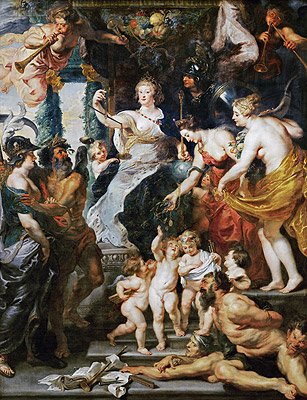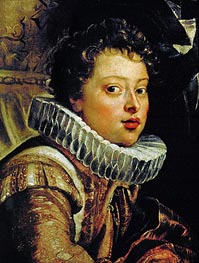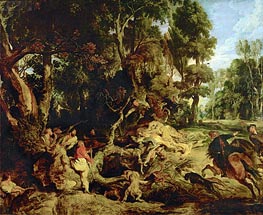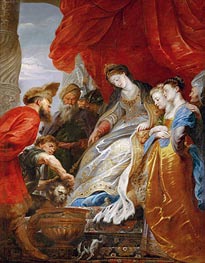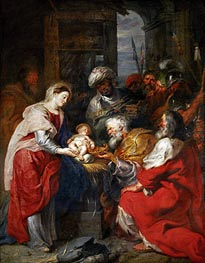The Felicity of the Regency, c.1621/25 by Peter Paul Rubens
Canvas Print - 13763-RPP
Location: Louvre Museum, Paris, FranceOriginal Size: 394 x 295 cm
Giclée Canvas Print | $64.19 USD
Your Selection
Customize Your Print
By using the red up or down arrows, you have the option to proportionally increase or decrease the printed area in inches as per your preference.
*Max printing size: 41.3 x 31.7 in
*Max framing size: Long side up to 28"
"The Felicity of the Regency" will be custom-printed for your order using the latest giclée printing technology. This technique ensures that the Canvas Print captures an exceptional level of detail, showcasing vibrant and vivid colors with remarkable clarity.
Our use of the finest quality, fine-textured canvas lends art reproductions a painting-like appearance. Combined with a satin-gloss coating, it delivers exceptional print outcomes, showcasing vivid colors, intricate details, deep blacks, and impeccable contrasts. The canvas structure is also highly compatible with canvas stretching frames, further enhancing its versatility.
To ensure proper stretching of the artwork on the stretcher-bar, we add additional blank borders around the printed area on all sides.
Our printing process utilizes cutting-edge technology and employs the Giclée printmaking method, ensuring exceptional quality. The colors undergo independent verification, guaranteeing a lifespan of over 100 years.
Please note that there are postal restrictions limiting the size of framed prints to a maximum of 28 inches along the longest side of the painting. If you desire a larger art print, we recommend utilizing the services of your local framing studio.
*It is important to mention that the framing option is unavailable for certain paintings, such as those with oval or round shapes.
If you select a frameless art print of "The Felicity of the Regency" by Rubens, it will be prepared for shipment within 48 hours. However, if you prefer a framed artwork, the printing and framing process will typically require approximately 7-8 days before it is ready to be shipped.
We provide complimentary delivery for up to two unframed (rolled-up) art prints in a single order. Our standard delivery is free and typically takes 10-14 working days to arrive.
For faster shipping, we also offer express DHL shipping, which usually takes 2-4 working days. The cost of express shipping is determined by the weight and volume of the shipment, as well as the delivery destination.
Once you have added the paintings to your shopping cart, you can use the "Shipping estimates" tool to obtain information about available transport services and their respective prices.
All unframed art prints are delivered rolled up in secure postal tubes, ensuring their protection during transportation. Framed art prints, on the other hand, are shipped in cardboard packaging with additional corner protectors for added safety.
Painting Information
Marie de' Medici, die Ehefrau von Heinrich IV., übernahm nach der Ermordung des Herrschers im Jahr 1610 die Regentschaft über das französische Königreich. Im Jahr 1621 beauftragte sie den flämischen Maler Pieter Paul Rubens (dessen Ruhm sich bereits über sein Heimatland hinaus verbreitet hatte) mit der Ausschmückung von zwei Galerien in ihrem Luxemburger Palast, die jeweils Heinrich IV. und ihr selbst gewidmet waren. Der Künstler wurde gebeten, sich zunächst auf die zweite Galerie zu konzentrieren. Rubens schickte die ersten Skizzen, und am 24. Mai 1623 traf er in Paris mit neun Gemälden ein, die er in seinem Antwerpener Atelier begonnen hatte und die er an Ort und Stelle vollenden sollte. Das Ensemble von insgesamt vierundzwanzig Gemälden (von denen die meisten unter dem Pinsel des Künstlers entstanden), auf denen verschiedene Episoden aus dem Leben von Marie de' Medici dargestellt sind, wird im Mai 1625 vollendet. Die Gemälde wurden in den Louvre gebracht und in der eigens für ihre Aufnahme umgebauten Galerie aufgestellt. Im Palais du Luxembourg fiel das Licht aus den Fenstern zwischen den Gemälden auf sie, im Louvre war die Beleuchtung zenithal.
Die Götter und Göttinnen stiegen im Augenblick der Geburt der Königin vom Olymp herab und begleiteten sie ihr ganzes Leben lang. Sie verherrlichen die Sternstunden ihrer Regentschaft oder unterstützen sie in den Unglücken und Auseinandersetzungen, die sie durchlebt. Nachdem sie am 26. April 1573 in Florenz das Licht der Welt erblickt hatte (Bild II), lernte sie in Gegenwart des Gottes Apollo und unter dem wachsamen Blick der drei Grazien lesen (Bild III). Am 3. November 1600 kommt Maria de' Medici in Marseille an. Frankreich empfängt sie (Bild VI), bevor sie nach Lyon reist, wo ihre Hochzeit mit Heinrich IV. vollzogen wird (Bild VII). Nach der Geburt Ludwigs XIII. am 27. September 1601 (Gemälde VIII) schildert der Künstler den Tod Heinrichs IV., die der Königin anvertraute Regentschaft (Gemälde X) sowie ihren Rausch an der Eminenz (Gemälde XV), ohne die schweren Stunden während der Flucht aus dem Schloss von Blois im Jahr 1619 (Gemälde XVII) auszulassen.
Rubens stellt seine ganze Vorstellungskraft und Begabung in den Dienst der Herrscherin und entwirft das ideale, triumphale Bild der Herrscherin, ihrer Rolle in der Geschichte, ihrer Größe. Die Kompositionen - mal dynamisch, mal statisch - ziehen das Auge in eine Bewegung, die nie zu enden scheint. Das Licht in diesen üppigen, monumentalen Gemälden wirkt unwirklich. Es unterstreicht die Weite und Vollständigkeit der Figuren, die Schönheit der nackten Körper, die Üppigkeit von Rot und Gold. Ein kraftvoller Atem erfüllt jede der Szenen und verwandelt das Ensemble in eines der Meisterwerke der Barockkunst.
